A Flood Risk Assessment Model for Companies and Criteria for Governmental Decision-Making to Minimize Hazards
Abstract
1. Introduction
2. Method
2.1. Related Works
2.2. The FRAC (Relative Flood Risk Assessment for Company) Model
2.2.1. RiskLocation
2.2.2. RiskCompany
2.2.3. RiskFlood
3. Case Study
3.1. Study Context
3.2. Results of the Case Study Using the FRAC Model
3.2.1. Which Industrial Parks Are Vulnerable to Floods and Need Government Support
3.2.2. What Risk Items of Companies Should the Government Support to Reduce the Country’s Overall Flood Risk
3.3. Use of Evaluation Results in Government Decision-Making
4. Conclusions
Acknowledgments
Author Contributions
Conflicts of Interest
Appendix A. Questionnaire Assessing the Impact of Floods on Companies
| |||||||
| 1 | 2 | 3 | 4 | 5 | |||
| Profit creation | Exceeded | V | No profit | ||||
| Stable demand of production | Exceeded | V | Goal not achieved | ||||
| Supply of raw materials | Stable supply | V | Interruption of supply | ||||
| Human resources | Stable supply | V | Interruption of supply | ||||
| Process | Exceeded | V | Process stop | ||||
| Was the process stopped due to the lack of water? If so, what are the costs and time of recovery or what are the costs of the damage? (Please fill out the following items for each of your company’s major processes.) | |||||||
| Occurrence date | (Date) | ||||||
| Occurrence condition | Air temperature (°C) | Seawater temperature (°C) | Precipitation (mm) | ||||
| Process stage in which facility damage or damage occurred | |||||||
| Damage intensity (downtime or cost of the facility) | |||||||
| |||||||
| Categories | Indicator | Scale | Value | ||||
| Equipment | Percentage of facility area affected by floods in company | % | |||||
| Inspection period for equipment or devices affected by flooding | Day | ||||||
| Average energy efficiency in company | |||||||
| Products | Percentage of products affected by flooding | % | |||||
| Percentage of warehouse area of the company in which flooding could be avoided | |||||||
| Raw materials | Percentage of raw materials affected by floods | % | |||||
Appendix B. Questionnaire Example of Assessing the Mesoscale Flood Risk
| |||||
| Risk items | Evaluate the degree of danger on a scale from 0 to 5 for each item. If it does not occur, it is 0; it is closer to 1 when it is not dangerous. | ||||
| Profit creation | Stable demand of production | Supply of materials | Human resources | Process | |
| Collapse of road slope and soil discharge | |||||
| Inundation and destruction of transportation vehicles due to typhoon or storms | |||||
References and Notes
- Pinkse, J.; Kolk, A. Challenges and trade-off in corporate innovation for climate change. Bus. Strategy Environ. 2010, 19, 261–272. [Google Scholar] [CrossRef]
- Ministry of Knowledge Economy. Research of Climate Change Vulnerability on Industrial Sector; Ministry of Knowledge Economy: Sejong, Korea, 2012; pp. 1–90.
- Rizzi, J.; Gallina, V.; Torresan, S.; Critto, A.; Gana, S.; Marcomini, A. Regional risk assessment addressing the impacts of climate change in the coastal area of the Gulf of Gabes (Tunisia). Sustain. Sci. 2016, 11, 455–476. [Google Scholar] [CrossRef]
- Khazai, B.; Merz, M.; Schulz, C.; Borst, D. An integrated indicator framework for spatial assessment of industrial and social vulnerability to indirect disaster losses. Nat. Hazards 2013, 67, 145–167. [Google Scholar] [CrossRef]
- Mechler, R. Natural Disaster Risk Management and Financing Disaster Losses in Developing Countries; Verlag für Versicherungswissenschaft: Karlsruhe, Germany, 2004. [Google Scholar]
- UKCIP. UK Climate Change Risk Assessment 2017: Evidence Report; UKCIP: Oxford, UK, 2017; p. 23. [Google Scholar]
- Hagiwara, Y.; Kuribayashi, D.; Sawano, H. Enhancement of Flood Countermeasures of Japanese-Affiliated Firms Based on the Lessons Learned from the 2011 Thai Flood. JDR 2016, 11, 1176–1189. [Google Scholar] [CrossRef]
- Gaume, E.; Bain, V.; Bernardara, P.; Newinger, O.; Barbuc, M.; Bateman, A.; Blaskovicova, L.; Bloschl, G.; Borgy, M.; Dumitrescu, A.; et al. A compilation of data on European flash floods. J. Hydrol. 2009, 367, 70–78. [Google Scholar] [CrossRef]
- Komolafe, A.A.; Adegboyega, S.A.A.; Akinluyi, F.O. A review of flood risk analysis in Nigeria. Am. J. Environ. Sci. 2015, 157–166. [Google Scholar] [CrossRef]
- Ryu, J.; Lee, D.K.; Park, C.; Ahn, Y.; Lee, S.; Choi, K.; Jung, T.Y. Assessment of the vulnerability of industrial parks to flood in South Korea. Nat. Hazards 2016, 82, 811–825. [Google Scholar] [CrossRef]
- Jang, J.; Lee, B.H. Problems of technology support to small business enterprises: Focusing on industry-academy-laboratory collaboration. Korea Gov. Rev. 2006, 13, 223–245. [Google Scholar]
- UCKIP, BACLIAT Vulnerability Assessment. UK. 2014. Available online: http://www.ukcip.org.uk/wizard/future-climate-vulnerability/bacliat/ (accessed on 30 May 2017).
- Committee on Climate Change, UK Climate Change Risk Assessment 2017: Evidence Report. 2017, pp. 28–103. Available online: https://www.theccc.org.uk/wp-content/uploads/2016/07/UK-CCRA-2017-Chapter-6-Business-and-industry.pdf (accessed on 30 May 2017).
- Vu, T.T.; Ranzi, R. Flood risk assessment and coping capacity of floods in central Vietnam. J. Hydrol. Environ. Res. 2013, 14, 44–60. [Google Scholar] [CrossRef]
- Dutta, D.; Herath, S.; Musiake, K. A mathematical model for flood loss estimation. J. Hydrol. 2003, 277, 24–49. [Google Scholar] [CrossRef]
- FEMA. Flood Map Modernization Mid-Course Adjustment; FEMA: Washington, DC, USA, 2006.
- FEMA. CRS Coordinator’s Manual Changes; FEMA: Washington, DC, USA, 2012.
- Scawthorn, C.; Flores, P.; Blais, N.; Seligson, H.; Tate, E.; Chang, S.; Mifflin, E.; Thomas, W.; Murphy, J.; Jones, C.; et al. HAZUS-MH flood loss estimation methodology, II. Damage and loss assessment. Nat. Hazards Rev. 2006, 7, 72–81. [Google Scholar] [CrossRef]
- Klijn, F.; de Bruijn, K.M.; Knoop, J.; Kwadijk, J. Assessment of The Netherlands’ Flood Risk Management Policy under Global Change. AMBIO 2012, 41, 180–192. [Google Scholar] [CrossRef] [PubMed]
- Vergouwe, R.; Sarink, H. The National Flood Risk Analysis for The Netherlands; Rijkswaterstaat VNK Office: Roermond, The Netherlands, 2016; pp. 1–120. [Google Scholar]
- Yang, J.S.; Park, J.H.; Kim, N.K. Development of drought vulnerability index using trend analysis. KSCE 2012, 5, 185–192. [Google Scholar]
- Birkmann, J. Risk and vulnerability indicators at different scales: Applicability, usefulness and policy implications. Environ. Hazards 2007, 7, 20–31. [Google Scholar] [CrossRef]
- Merz, M.; Hiete, M.; Comes, T.; Schultmann, F. A composite indicator model to assess natural disaster risks in industry on a spatial level. J. Risk Res. 2013, 16, 1077–1099. [Google Scholar] [CrossRef]
- Sun, Z.; Zhang, J.; Zhang, Q.; Hu, Y.; Yan, D.; Wang, C. Integrated risk zoning of drought and waterlogging disasters based on fuzzy comprehensive evaluation in Anhui Province, China. Nat. Hazards 2014, 71, 1639–1657. [Google Scholar] [CrossRef]
- Rodrigues, M.A.; Zrezes, P.M.; Leao, C.P. Defining risk acceptance criteria in occupational settings: A case study in the furniture industrial sector. Saf. Sci. 2015, 80, 288–295. [Google Scholar] [CrossRef]
- Ahn, S. A case study of the risk identification in construction project. KJCEM 2015, 16, 15–23. [Google Scholar] [CrossRef]
- Lee, S.M.; Kim, S.M.; Lee, Y.H. Introduction of the B(i,j,k) BCP and risk assessment of underground limestone mine. Tunn. Undergr. Space 2012, 22, 383–392. [Google Scholar] [CrossRef]
- Smith, K. Environmental Hazards: Assessing Risk and Reducing Disaster, 2nd ed.; Routledege: London, UK; Philadelphia, PA, USA; Winnipeg, MB, Canada, 1996. [Google Scholar]
- Brooks, N. Vulnerability, Risk and Adaptation: A Conceptual Framework; Tyndall Centre Working Paper; Tyndall Centre: Norwich, UK, 2003. [Google Scholar]
- Anbalagan, R.; Singh, B. Landslide hazard and risk assessment mapping of mountainous terrains: A case study from Kumaun Himalaya, India. Eng. Geol. 1996, 43, 237–246. [Google Scholar] [CrossRef]
- Hamidin, N.; Yu, O.J.; Connell, D.W. Human health risk assessment of chlorinated disinfection by-products in drinking water using a probabilistic approach. Water Res. 2008, 42, 3263–3274. [Google Scholar] [CrossRef] [PubMed]
- Zhang, K.; Pei, Y.; Lin, C. An investigation of correlations between different environmental assessments and risk assessment. Procedia Environ. Sci. 2010, 2, 643–649. [Google Scholar] [CrossRef]
- Torabi, S.A.; Soufi, H.R.; Sahebjamnia, N. A new framework for business impact analysis in business continuity management (with a case study). Saf. Sci. 2014, 68, 309–323. [Google Scholar] [CrossRef]
- Torabi, S.A.; Giahi, R.; Sahebjamnia, N. An enhanced risk assessment framework for business continuity management. Saf. Sci. 2016, 89, 201–218. [Google Scholar] [CrossRef]
- Xin, Z.; Xiaohu, X.; Kaili, X. Study on the risk assessment of the Tailings Dam Break. Procedia Eng. 2011, 26, 2261–2269. [Google Scholar] [CrossRef]
- IPCC. Climate Change 2014 Synthesis Report; Contribution of Working Groups I, II and III to the Fifth Assessment Report of the Intergovernmental Panel on Climate Change; Core Writing Team, Pachauri, R.K., Meyer, L.A., Eds.; IPCC: Geneva, Switzerland, 2014; p. 151. [Google Scholar]
- Winsemius, H.C.; Van Beek, L.P.H.; Jongman, B.; Ward, P.J.; Bouwman, A. A framework for global river flood risk assessments. Hydrol. Earth Syst. Sci. 2013, 17, 1871–1892. [Google Scholar] [CrossRef]
- Kang, H.W.; Min, B.J.; Kim, Y.S. A study on the Costs Variation Range through the Risk Factors for Overseas Plant Projects. J. Architect. Inst. Korea 2010, 7, 139–146. [Google Scholar]
- Hay, J.; Mimura, N. The changing nature of extreme weather and climate events: risks to sustainable development, Geomatics. Natl. Hazards Risk 2010, 1, 3–18. [Google Scholar] [CrossRef]
- Foudi, S.; Oses-Eraso, N.; Tamayo, I. Integrated spatial flood risk assessment: The case of Zaragoza. Land Use Policy 2015, 42, 278–292. [Google Scholar] [CrossRef]
- Renn, O. The role of risk perception for risk management. Reliab. Eng. Syst. Saf. 1998, 59, 49–62. [Google Scholar] [CrossRef]
- Renn, O. Three decades of risk research: Accomplishments and new challenges. J. Risk Res. 1998, 1, 49–71. [Google Scholar] [CrossRef]
- UNDP. Adaptation Policy Frameworks for Climate Change: Developing Strategies, Polices, and Measures; Cambridge University Press: Cambridge, MA, USA, 2005. [Google Scholar]
- Jiang, F.; Tatano, H.; Kuzuha, Y.; Matsuura, T. Economic Loss Estimation of Water Supply Shortage Based on Questinaire Survey in Industrial Sectors; Report of the National Institute; National Research Institute for Earth Science and Disaster Prevention: Tsukuba, Japan, 2005.
- Rose, A.; Lim, D. Business interruption losses from natural hazards: Conceptual and methodological issues in the case of the Northridge earthquake. Environ. Hazard 2002, 4, 1–14. [Google Scholar]
- Chen, Y.; Song, G.; Yang, F.; Shushen, S.; Zhang, Y.; Liu, Z. Risk assessment and hierarchical risk management of enterprises in chemical industrial parks based on catastrophe theory. Int. J. Environ. Res. Public Health 2012, 9, 4386–4402. [Google Scholar] [CrossRef] [PubMed]
- Kim, J.; Sung, H.H.; Choi, G. Spatial patterns of urban flood vulnerability in Seoul. J. Korean Assoc. Reg. Geogr. 2013, 19, 615–626. [Google Scholar]
- Hamdani, Y.; Setyawn, D.; Setiawan, B.; Affandi, A.K. Mainstreaming adaptation climate change into Strategic environmental assessment case study Banyusain District, South Sumatra Province. J. Sustain. Dev. 2015, 7, 8–17. [Google Scholar]
- Kaliraj, S.; Chandrasekar, N.; Peter, T.S.; Selvakumar, S.; Magesh, N.S. Mapping of coastal aquifer vulnerable zone in the south west coast of Kanyakumari, South India, using GIS-based DRASTIC model. Environ. Monit. Assess. 2015, 187, 4073–4099. [Google Scholar] [CrossRef] [PubMed]
- Bing, G.; Yi, Z.; Fingeng, Z.; Wenliang, L.; Futao, W.; Litao, W.; Fuli, Y.; Wang, F.; Guang, Y.; Wei, L.; et al. Spatial patterns of ecosystem vulnerability changes during 2001–2011 in the three-river source region of the Qinghai-Tivetan Plateau, China. J. Arid Land 2016, 8, 23–35. [Google Scholar]
- Kim, D.H. Risk assessment and Classification for climate change adaptation: Application on the Method of climate change risk assessment in the UK. J. Environ. Policy 2015, 14, 53–83. [Google Scholar]
- DEFRA. The UK Climate Change Risk Assessment; Evidence Report; DEFRA: London, UK, 2012.
- Joint Ministry of Republic of Korea. Reviewed First National Climate Change Adaptation Policy; Joint Ministry of Republic of Korea: Seoul, Korea, 2015; pp. 9–147.
- Ministry of Environment. Climate Change Vulnerability Map for Detailed Government Adaptation Policy; Ministry of Environment: Gwacheon, Korea, 2012.
- International Monetary Fund. World Economic Outlook Database; International Monetary Fund: Washington, DC, USA, 18 April 2017. [Google Scholar]
- Ministry of Environment. Water Demand Forecast Manual; Ministry of Environment: Gwacheon, Korea, 2014.
- Bae, D.H.; Lee, M.W. Flood vulnerability assessment and case analysis based on climate change. Plan. Policy 2010, 344, 20–31. [Google Scholar]
- Lee, M.W.; Kim, T.W.; Moon, G.W. Assessment of flood damage vulnerability considering regional flood damage characteristics in South Korea. J. Korean Soc. Hazard Mitig. 2013, 13, 245–256. [Google Scholar] [CrossRef]
- Hong, J.H.; Hwang, J.H. Analysis on the change of regional vulnerability to flood. Environ. Policy Res. 2006, 5, 1–18. [Google Scholar]
- Huh, M.; Lim, C. A study on the competitiveness reinforcement based on the analysis of industrial complexes using vital index. Reg. Dev. Stud. 2012, 44, 75–96. [Google Scholar]
- Oh, M.D. Clean Room Air Conditioning and Environmental Control System. Facil. Soc. 1991, 20, 391–408. [Google Scholar]
- Chung, J.; Kim, J.; Baek, S. The strategy of innovation fund raising for the old industrial complex. Constr. Econ. Ind. Res. 2014, 5, 67–92. [Google Scholar]
- Industrial Sites and Development Act. No. 14480. Directive 29 December 2009, Professional Revision 4 August 2011. Republic of Korea.
- Kim, T.H.; Lim, D.I. The regeneration policy of deteriorated industrial complexes: The case study of Ulsan industrial complex. Wonju City. KDI 2014, 26, 159–180. [Google Scholar]
- Jang, C.S.; Jung, C.J.; Na, J.M.; Shin, W.J.; Jung, W.G.; Jung, J.W. Status and Tasks of Regeneration of old industrial complex. UEIS 2015, 397, 4–20. [Google Scholar]
- Act on Special for Promoting Vitality and Strengthening Competitiveness of Old Industrial Park. Ministry of Trade, No. 13879. Directive 27 January 2016, Apply 28 January 2017. Republic of Korea.
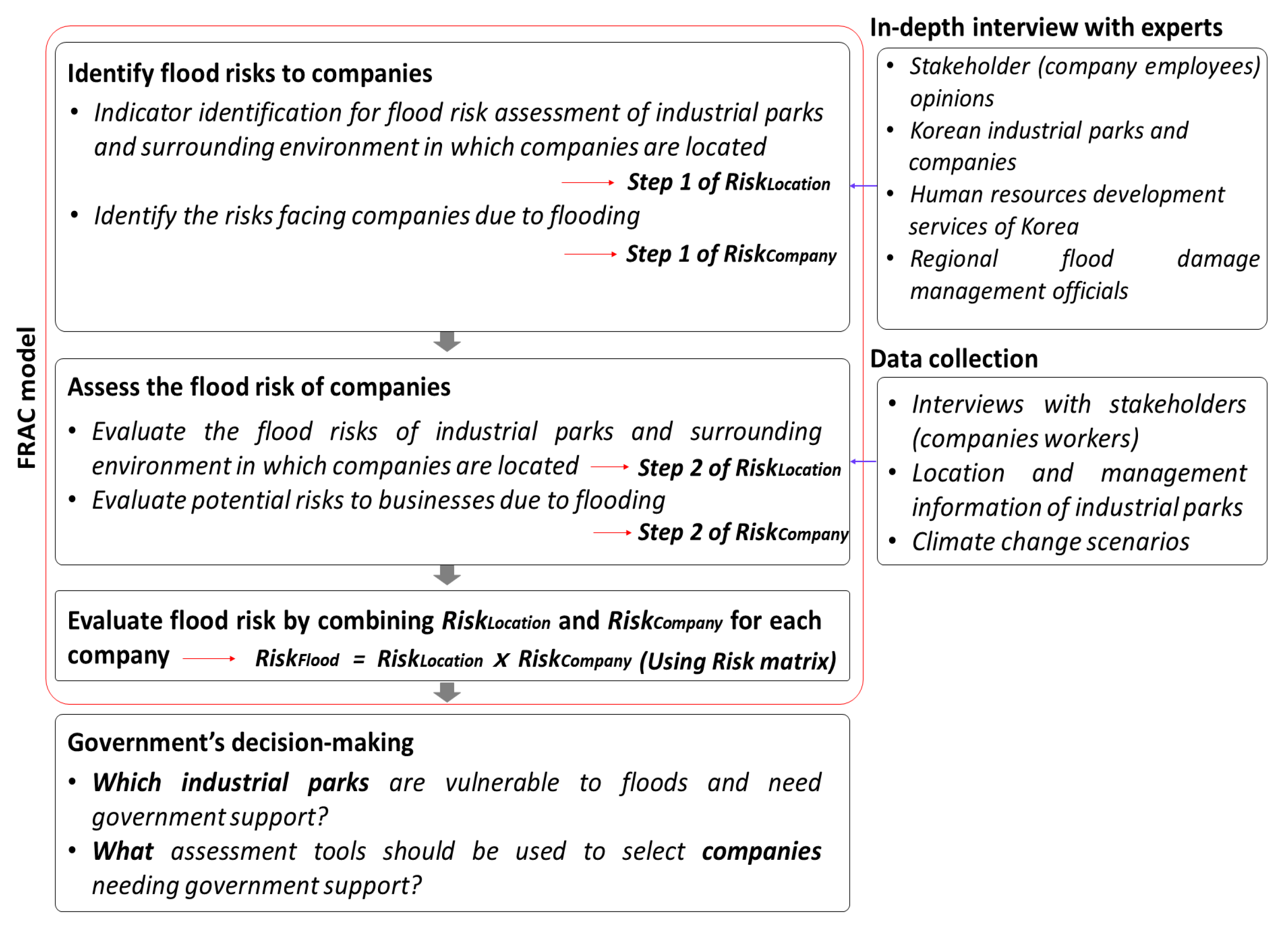
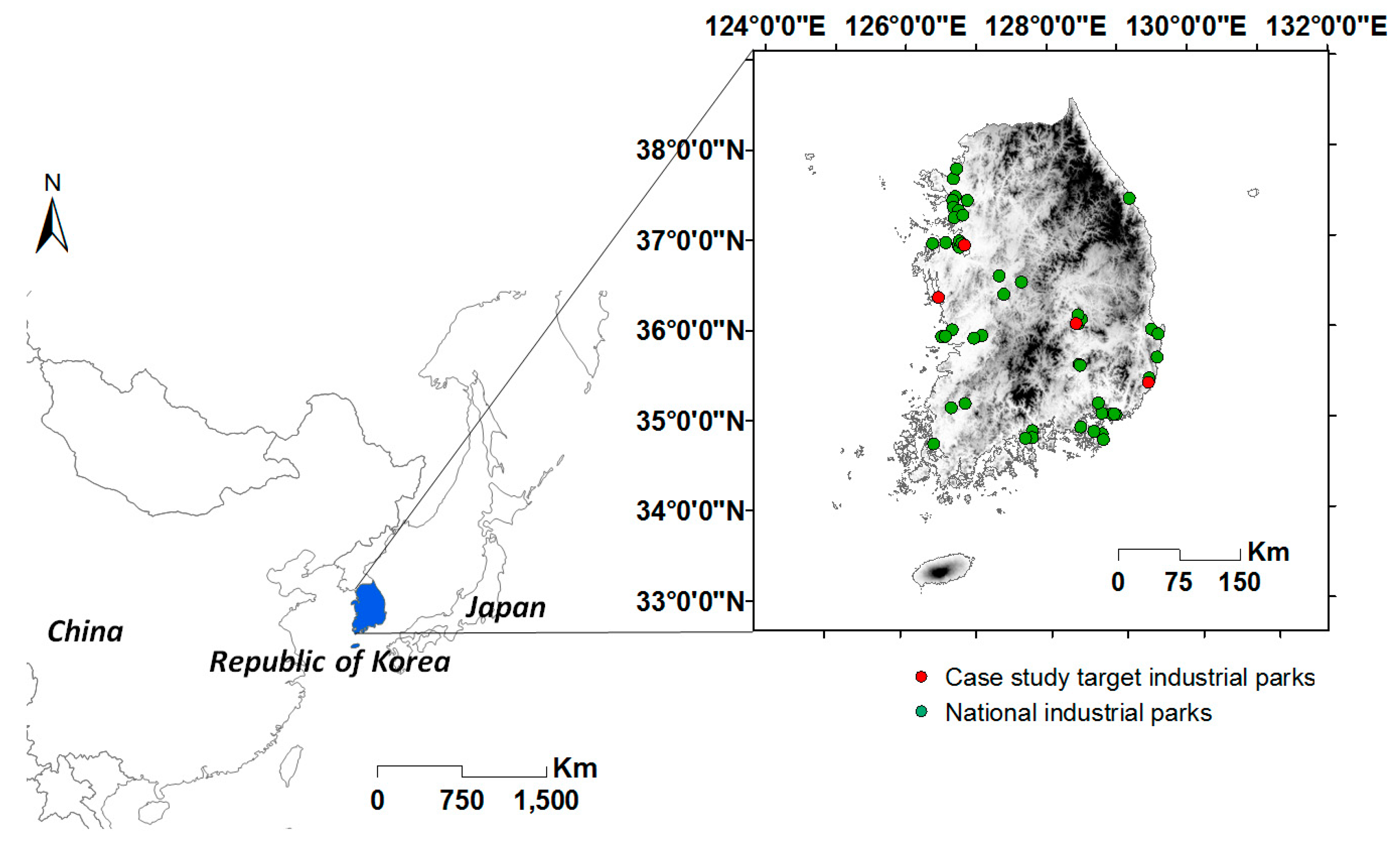
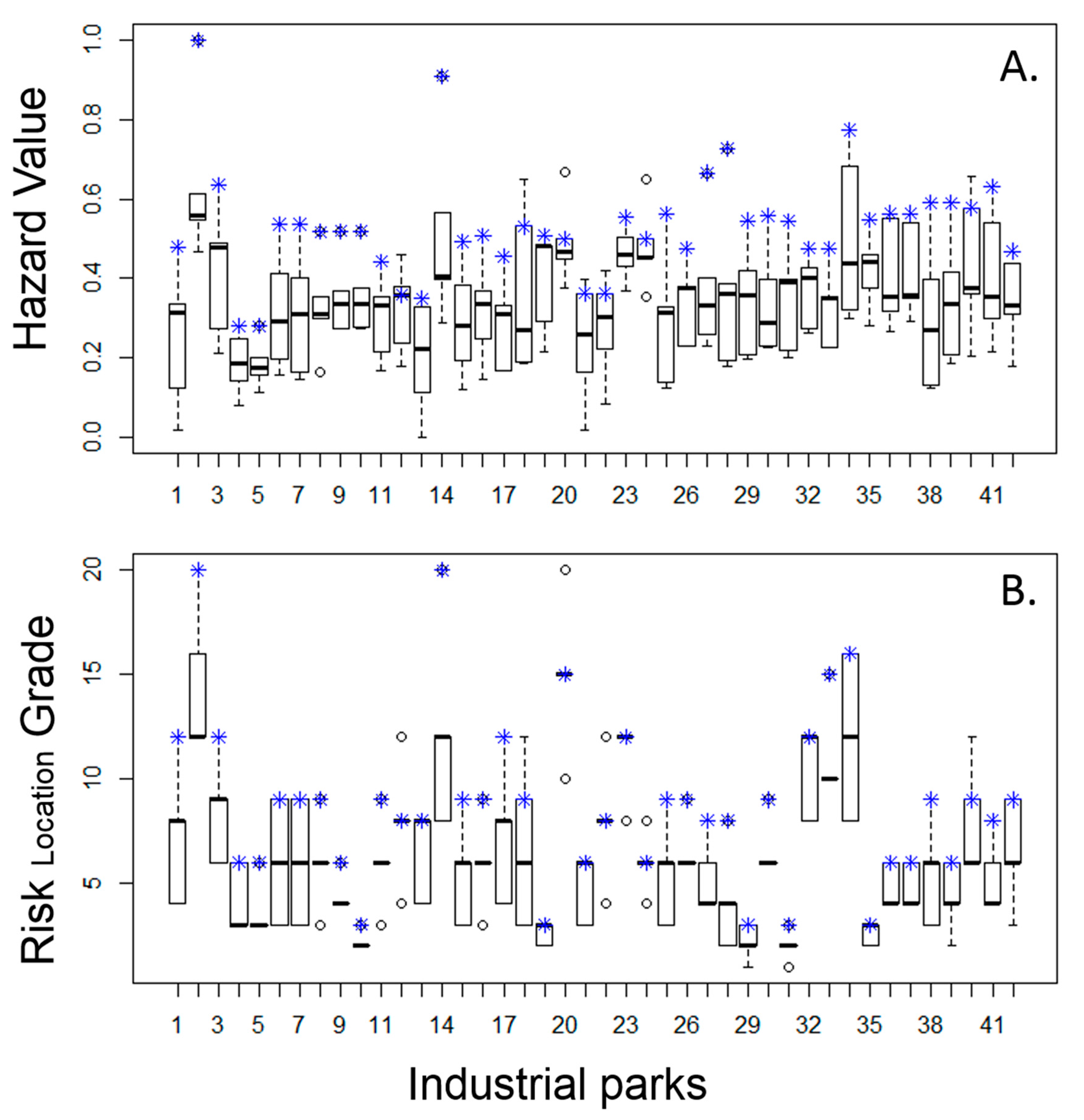
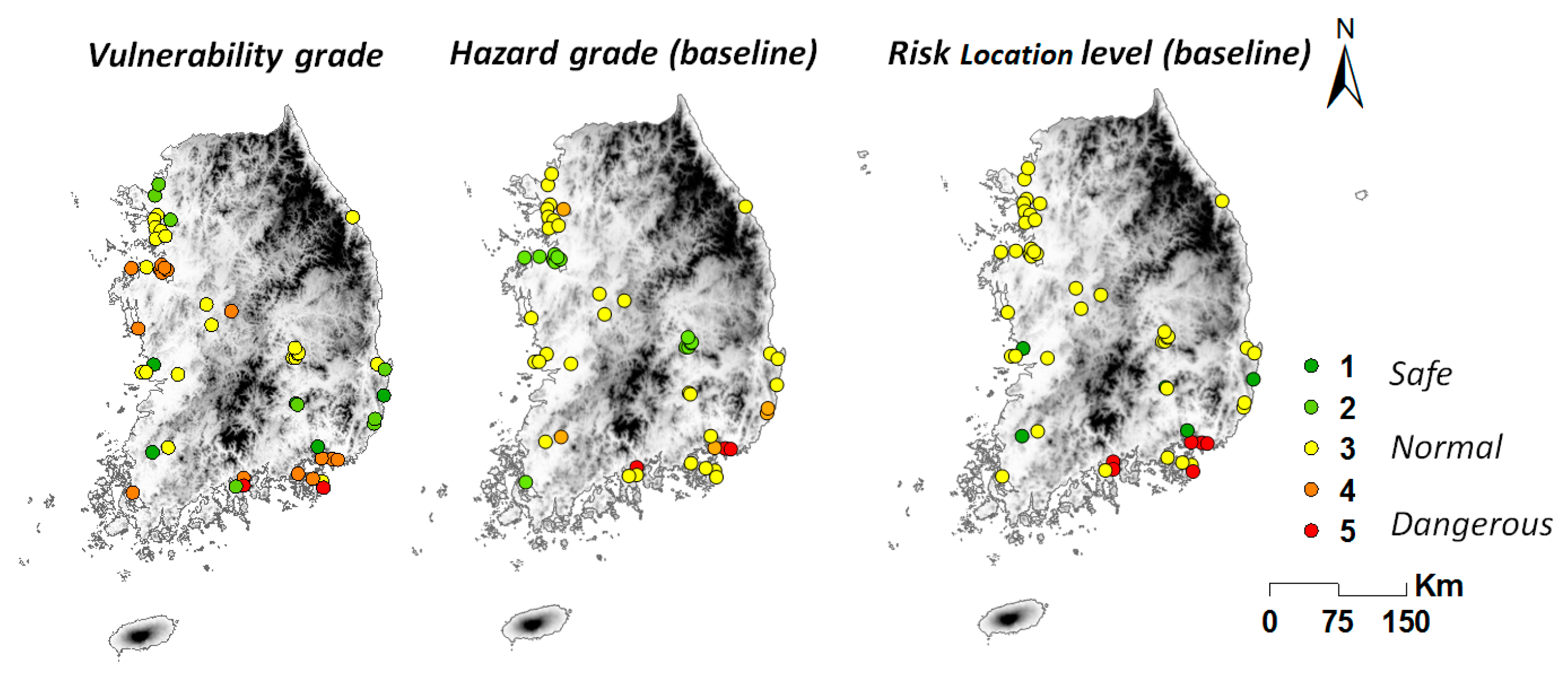
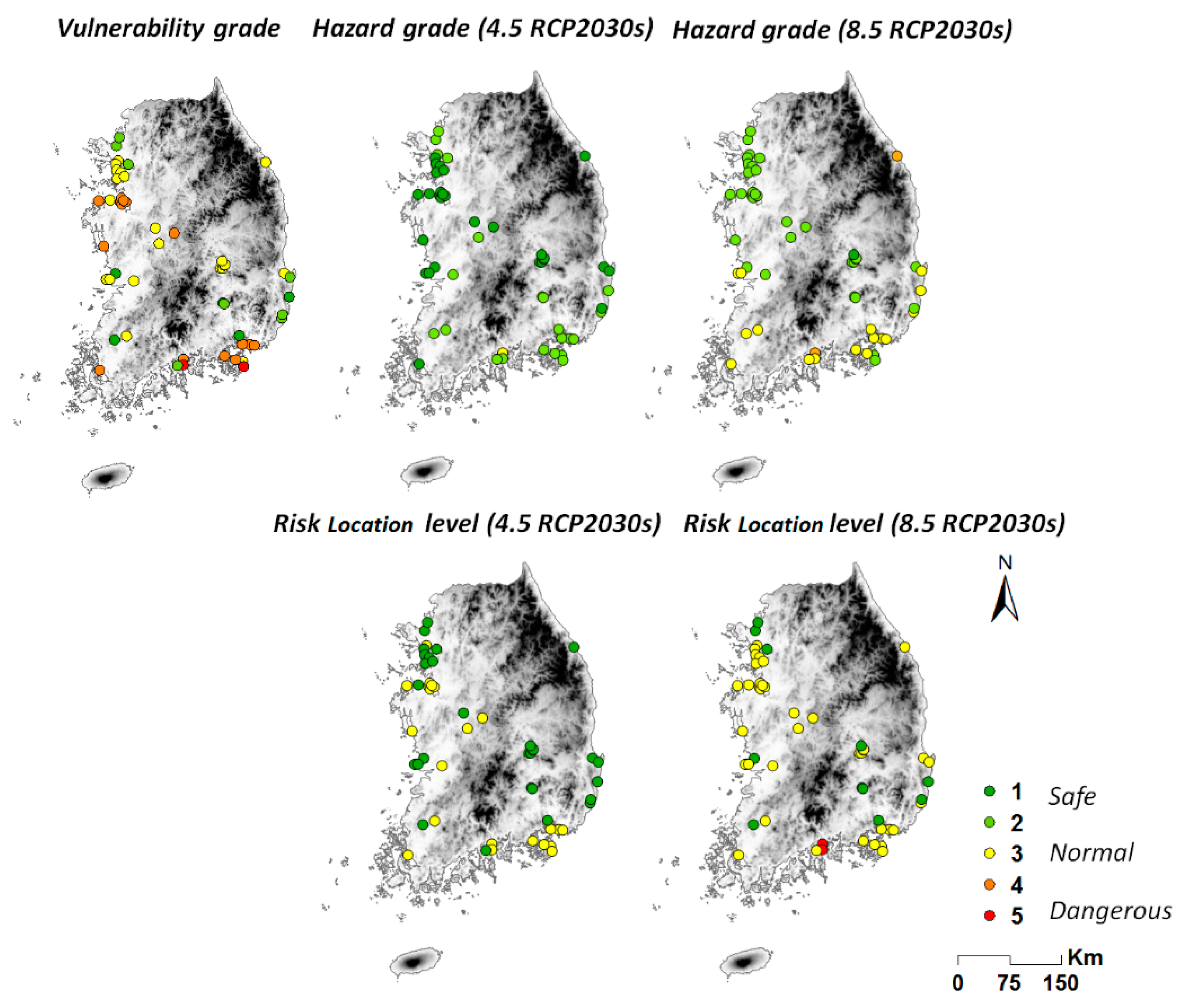
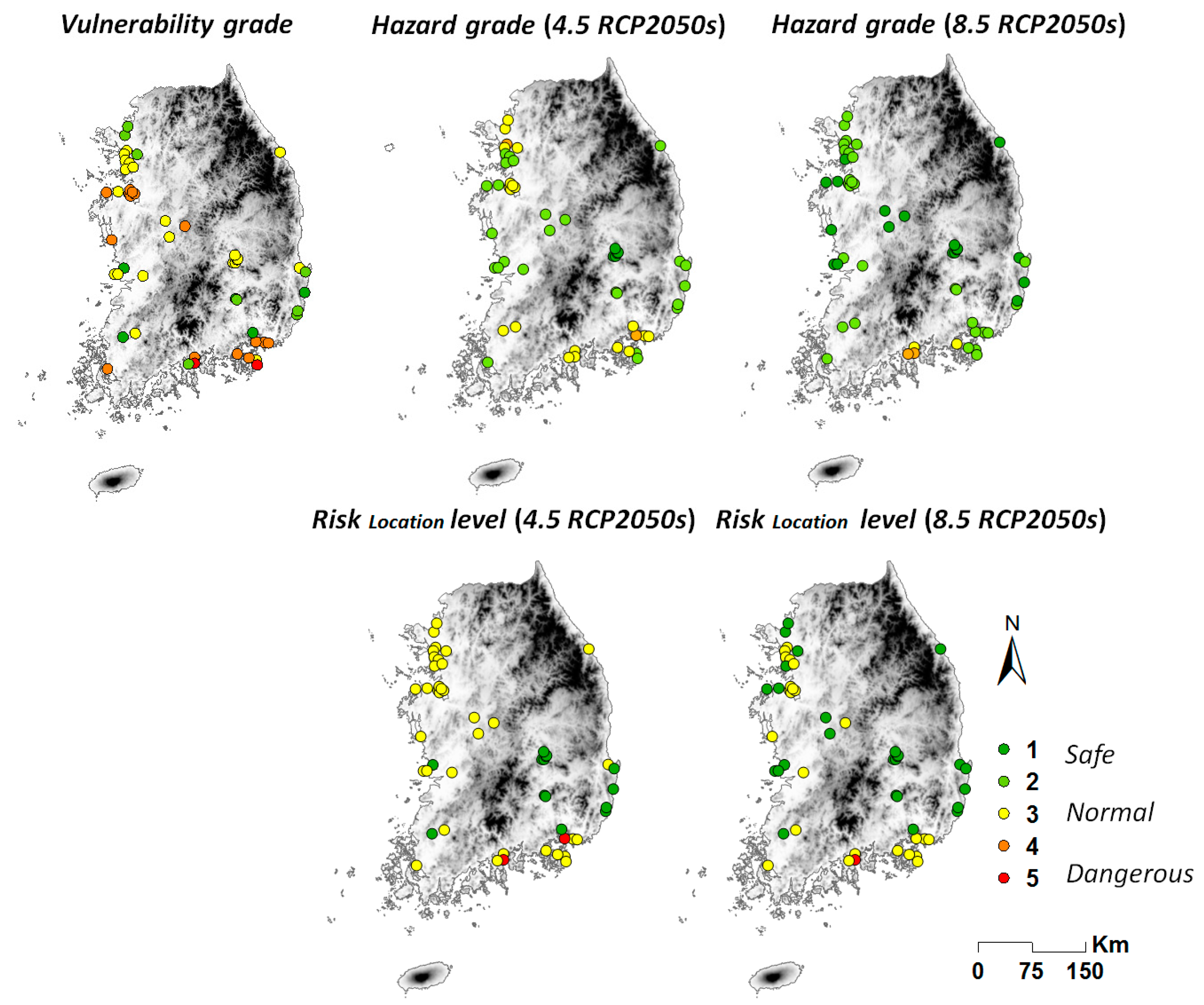
| Categories | Indicators | Index | Flood Risk List (Sub-Indicators) | Score Scale | Source |
|---|---|---|---|---|---|
| Hazard | Hazard | Precipitation | More than 100 mm of daily rain per year | Total number of days | Representative Concentration Pathways (RCP) scenario (Korea Meteorological Administration) |
| five-day maximum rainfall period | Total number of days | ||||
| Vulnerability | Sensitivity | Infrastructure | Water ratio in industrial parks | % | Land cover data (Ministry of Environment) |
| Outdated facilities | Year of construction | Industrial parks information (Korea Industrial Parks Corporation) | |||
| Characteristics of industrial sectors | Ratio of vulnerable business types 1 | % | |||
| Location of industrial parks | Slope | Degree | Digital Elevation Model (DEM) Geographic Information System (GIS) data | ||
| Industrial park area within 100 m of mountains | m2 | Land cover data (Ministry of Environment) | |||
| Soil characteristics within 100 m of mountains 2 | 1–6 | Soil characteristics map (Korean Soil Information System) | |||
| Coastal landfill location | Landfill: 1 Out of landfill: 0 | Industrial parks information (Korea Industrial Parks Corporation) | |||
| Number of roads | Total number | Google Maps | |||
| Distance from coast and river (within 1 km) | Meters | Google Maps | |||
| Adaptation | Infrastructure | Emergency power supply facilities | Yes: 1/No: 0 | Industrial parks information (Korea Industrial Parks Corporation) | |
| Number of fire stations in city | Total number | Internet search | |||
| Number of medical facilities in city | Total number | Internet search | |||
| Green space ratio (green space area/industrial area) | % | Land cover data (Ministry of Environment) | |||
| Flood reduction facilities | Total number | Contact local government | |||
| Technical skills and funds for climate adaptation | Investment in facilities | Total amount | Industrial parks information (Korea Industrial Parks Corporation) |
| Range of Hazard (H) and Vulnerability (V) | RiskLocation j | Risk Matrix | |||
|---|---|---|---|---|---|
| Grade | Range of Raw Data | Range of H and V Level | RiskLocation j Value (H × V) | RiskLocation j Level | 
|
| 1 | 0–0.2 | H {1, 2, 3}, V {1, 2, 3} | 1–3 | 1 | |
| 2 | 0.2–0.4 | H {2}, V {2} | 4 | ||
| 3 | 0.4–0.6 | H {1, 2, 3, 4, 5}, V {1, 2, 3, 4, 5} | 4–12 | 2 | |
| 4 | 0.6–0.8 | H {1, 2, 3, 4}, V {1, 2, 3, 4} | 4 | ||
| 5 | 0.8–1.0 | H {3, 4, 5}, V {3, 4, 5} | 15–25 | 3 | |
| Categories | Flood Risk List | Final Flood Risk to Be Assessed Considering Both Probability and Consequence |
|---|---|---|
| Transportation & Logistics | Road flooding and collapse | |
| Road slope collapse and sediment discharge | ||
| Inundation and damage to transportation vehicles due to typhoons and heavy rain | ||
| Loss of raw materials and damage in case of heavy rainfall | ||
| Impassable roads | ||
| Damage to product transportation facilities | ||
| Significant increase in traffic accidents (railways, roads) | ||
| Production | Flooding and collapse of production facilities | ○ (Risk 1) |
| Concerns about the destruction and overturning of various and large equipment | ||
| Increased possibility of building collapse due to strong winds and heavy rain | ||
| Power supply interruption due to power station and substation damage (production system paralysis) | ○ (Risk 3) | |
| Unsafe roads due to flooding | ||
| Damage to water treatment facilities | ||
| Increase of polluted water outflow due to flooding | ||
| Increase in energy consumption for maintaining constant temperature and humidity when the outside temperature is lowered due to prolonged, heavy rains | ||
| Increased humidity degrading raw materials and final products | ○ (Risk 2) | |
| Increased possibility of mixed discharge of waste due to flooding | ||
| Damage and collapse of waste treatment facilities due to typhoons and floods | ||
| Workers | Increased worker mortality caused by factors such as facility collapse and electrocution | |
| Increased worker injury due to lightning, etc. | ||
| Increased possibility of workers’ mental health problems (posttraumatic stress) | ||
| Outdoor workers inability to work due to flooding | ||
| Location | Increased probability of flood damage due to heavy rainfall and high tide overlap | |
| Increased probability of flood damage due to aging domestic water exclusion facilities | ||
| Increased probability of flooding within the workplace and nearby coasts | ||
| Finance | Increase in personal and material insurance costs due to floods | |
| Increased cost of repairing damaged facilities | ||
| Added transportation costs due to disruption in infrastructure supply and demand | ||
| Difficulties in shipping products and with respect to the costs of claiming damages due to the flood | ||
| Market | Increased possibility of supply chain damage in other companies related to product manufacturing | |
| Decrease in the quality of products |
| Profit-Making | Accomplishment | Supply of Materials and Tools | Human Resources | Process | Consequence Grade (C) |
|---|---|---|---|---|---|
| No profit | Did not achieve the goal | Supply is interrupted | Manpower vacuum | Suspended | 5 (very risky) |
| Goal not achieved | Did not achieve the goal | Supply is delayed for a long period of time | Not sufficient for a long period of time | Supply is delayed for a long period of time | 4 (risky) |
| Goal achieved | Achieved the goal | Supply is delayed | Not sufficient for a short period of time | Process is delayed | 3 (normal) |
| Achieved, partially exceeding the goal | Achieved, partially exceeding the goal | Supply is delayed for a short period of time | Slight problem | Process is delayed for a short period of time | 2 (not very risky) |
| Achieved, exceeding the goal | Achieved, exceeding the goal | Stable supply | Smooth | Achieved the process | 1 (not risky) |
| Grade of P | Evaluation Standard of the Risk Probability for Each Risk Item (P) | RiskCompany i | Risk Matrix | ||
| Range of Raw Data Value | Range of C and P Level | RiskCompany i Value (C × P) | RiskCompany i Level | 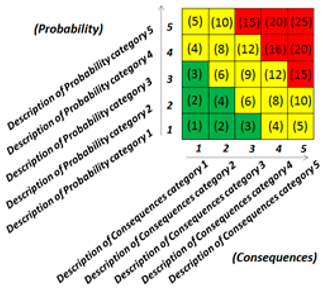
| |
| 1 | No damage occurred in the past and the probability is very low | C {1, 2, 3}, P {1, 2, 3} | 1–3 | 1 | |
| 2 | Damage was not recorded in the past; however, considering the location’s physical features, the probability of risk is moderate to low | C {2}, P {2} | 4 | ||
| 3 | Damage was recorded in the past; considering the geographical location and environment, the probability is high to extremely high | C {1, 2, 3, 4, 5}, P {1, 2, 3, 4, 5} | 4–12 | 2 | |
| 4 | Actual damage (various cases within the last 10 years), no damage and recovery costs | C {1, 2, 3, 4}, P {1, 2, 3, 4}, C ≠ P | 4 | ||
| 5 | Actual damage (various cases within the last 5 years), damage and recovery costs are incurred | C {3, 4, 5}, P {3, 4, 5} | 15–25 | 3 | |
| FRACji = RiskFlood ji | Risk Matrix | |
|---|---|---|
| RiskLocation j × RiskCompany ji | Level | |
| 1, 2 | 1 | 
|
| 3, 4 | 2 | |
| 6, 9 | 3 | |
| ① | ② | ① × ② | ||||||||||
|---|---|---|---|---|---|---|---|---|---|---|---|---|
| RiskLocation j (Level) | RiskCompany i (Level) | RiskFlood (Level) | ||||||||||
| Baseline | 2030s | 2050s | Baseline | 2030s | 2050s | |||||||
| RCP | RCP | RCP | RCP | RCP | RCP | RCP | RCP | |||||
| 4.5 | 8.5 | 4.5 | 8.5 | 4.5 | 8.5 | 4.5 | 8.5 | |||||
| TP | Risk 1 | 2 (2.00) | 2 (1.40) | 2 (1.79) | 2 (1.79) | 2 (1.48) | 3 | 3 | 3 | 3 | 3 | 3 |
| (1.50) | ||||||||||||
| Risk 2 | 2 | 2 | 2 | 2 | 2 | 2 | ||||||
| (1.75) | ||||||||||||
| Risk 3 | 1 | 1 | 1 | 1 | 1 | 1 | ||||||
| (1.50) | ||||||||||||
| EC | Risk 1 | 2 (2.00) | 1 (1.40) | 2 (1.79) | 1 (1.79) | 1 (1.48) | 1 | 1 | 1 | 1 | 1 | 1 |
| (1.50) | ||||||||||||
| Risk 2 | 2 | 2 | 1 | 2 | 1 | 1 | ||||||
| (1.75) | ||||||||||||
| Risk 3 | 2 | 2 | 1 | 2 | 1 | 1 | ||||||
| (1.50) | ||||||||||||
| EP SM | Risk 1 | 2 (2.00) | 2 (1.40) | 2 (1.79) | 2 (1.79) | 2 (1.48) | 1 | 1 | 1 | 1 | 1 | 1 |
| (1.50) | ||||||||||||
| Risk 2 | 2 | 2 | 2 | 2 | 2 | 2 | ||||||
| (1.75) | ||||||||||||
| Risk 3 | 2 | 2 | 2 | 2 | 2 | 2 | ||||||
| (1.50) | ||||||||||||
| PP | Risk 1 | 2 (2.00) | 1 (1.40) | 2 (1.79) | 1 (1.79) | 1 (1.48) | 1 | 1 | 1 | 1 | 1 | 1 |
| (1.50) | ||||||||||||
| Risk 2 | 2 | 2 | 1 | 2 | 1 | 1 | ||||||
| (1.75) | ||||||||||||
| Risk 3 | 1 | 1 | 1 | 1 | 1 | 1 | ||||||
| (1.50) | ||||||||||||
© 2017 by the authors. Licensee MDPI, Basel, Switzerland. This article is an open access article distributed under the terms and conditions of the Creative Commons Attribution (CC BY) license (http://creativecommons.org/licenses/by/4.0/).
Share and Cite
Ryu, J.; Yoon, E.J.; Park, C.; Lee, D.K.; Jeon, S.W. A Flood Risk Assessment Model for Companies and Criteria for Governmental Decision-Making to Minimize Hazards. Sustainability 2017, 9, 2005. https://doi.org/10.3390/su9112005
Ryu J, Yoon EJ, Park C, Lee DK, Jeon SW. A Flood Risk Assessment Model for Companies and Criteria for Governmental Decision-Making to Minimize Hazards. Sustainability. 2017; 9(11):2005. https://doi.org/10.3390/su9112005
Chicago/Turabian StyleRyu, Jieun, Eun Joo Yoon, Chan Park, Dong Kun Lee, and Seong Woo Jeon. 2017. "A Flood Risk Assessment Model for Companies and Criteria for Governmental Decision-Making to Minimize Hazards" Sustainability 9, no. 11: 2005. https://doi.org/10.3390/su9112005
APA StyleRyu, J., Yoon, E. J., Park, C., Lee, D. K., & Jeon, S. W. (2017). A Flood Risk Assessment Model for Companies and Criteria for Governmental Decision-Making to Minimize Hazards. Sustainability, 9(11), 2005. https://doi.org/10.3390/su9112005






